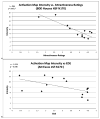Anorexia nervosa and body dysmorphic disorder are associated with abnormalities in processing visual information
- PMID: 25652023
- PMCID: PMC4898970
- DOI: 10.1017/S0033291715000045
Anorexia nervosa and body dysmorphic disorder are associated with abnormalities in processing visual information
Abstract
Background: Anorexia nervosa (AN) and body dysmorphic disorder (BDD) are characterized by distorted body image and are frequently co-morbid with each other, although their relationship remains little studied. While there is evidence of abnormalities in visual and visuospatial processing in both disorders, no study has directly compared the two. We used two complementary modalities--event-related potentials (ERPs) and functional magnetic resonance imaging (fMRI)--to test for abnormal activity associated with early visual signaling.
Method: We acquired fMRI and ERP data in separate sessions from 15 unmedicated individuals in each of three groups (weight-restored AN, BDD, and healthy controls) while they viewed images of faces and houses of different spatial frequencies. We used joint independent component analyses to compare activity in visual systems.
Results: AN and BDD groups demonstrated similar hypoactivity in early secondary visual processing regions and the dorsal visual stream when viewing low spatial frequency faces, linked to the N170 component, as well as in early secondary visual processing regions when viewing low spatial frequency houses, linked to the P100 component. Additionally, the BDD group exhibited hyperactivity in fusiform cortex when viewing high spatial frequency houses, linked to the N170 component. Greater activity in this component was associated with lower attractiveness ratings of faces.
Conclusions: Results provide preliminary evidence of similar abnormal spatiotemporal activation in AN and BDD for configural/holistic information for appearance- and non-appearance-related stimuli. This suggests a common phenotype of abnormal early visual system functioning, which may contribute to perceptual distortions.
Keywords: Dorsal/ventral visual streams; electroencephalography; event-related potential; face processing; house processing; joint ICA.
Conflict of interest statement
The authors have no conflicts of interest to disclose.
Figures







References
-
- Aguirre GK, Farah MJ. Human visual object recognition: What have we learned from neuroimaging? Psychobiology. 1998;26:322–332.
-
- American Psychiatric Association. Diagnostic and Statistical Manual of Mental Disorders DSM-5. 5. Arlington: American Psychiatric Publishing; 2013. p. 991.
-
- Bartlett J, Searcy J, Abdi H. Perception of Faces, Objects, and Scenes: Analytic and Holistic Processes. Oxford: Oxford University Press; 2003. What are the routes to face recognition? pp. 21–52.
-
- Booth R, Charlton R, Hughes C, Happé F, Happe F. Disentangling weak coherence and executive dysfunction: planning drawing in autism and attention 3 deficit / hyperactivity disorder. Philosophical Transactions of the Royal Society of London. Series B, Biological Sciences. 2003;358:387–392. - PMC - PubMed

